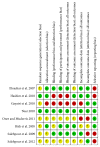N-acetylcysteine for polycystic ovary syndrome: a systematic review and meta-analysis of randomized controlled clinical trials
- PMID: 25653680
- PMCID: PMC4306416
- DOI: 10.1155/2015/817849
N-acetylcysteine for polycystic ovary syndrome: a systematic review and meta-analysis of randomized controlled clinical trials
Abstract
Objective. To review the benefits and harms of N-acetylcysteine (NAC) in women with polycystic ovary syndrome (PCOS). Method. Literature search was conducted using the bibliographic databases, MEDLINE (Ovid), CINAHL, EMBASE, Scopus, PsyInfo, and PROQUEST (from inception to September 2013) for the studies on women with PCOS receiving NAC. Results. Eight studies with a total of 910 women with PCOS were randomized to NAC or other treatments/placebo. There were high risk of selection, performance, and attrition bias in two studies and high risk of reporting bias in four studies. Women with NAC had higher odds of having a live birth, getting pregnant, and ovulation as compared to placebo. However, women with NAC were less likely to have pregnancy or ovulation as compared to metformin. There was no significant difference in rates of the miscarriage, menstrual regulation, acne, hirsutism, and adverse events, or change in body mass index, testosterone, and insulin levels with NAC as compared to placebo. Conclusions. NAC showed significant improvement in pregnancy and ovulation rate as compared to placebo. The findings need further confirmation in well-designed randomized controlled trials to examine clinical outcomes such as live birth rate in longer follow-up periods. Systematic review registration number is CRD42012001902.
Figures









Similar articles
-
First-line ovulation induction for polycystic ovary syndrome: an individual participant data meta-analysis.Hum Reprod Update. 2019 Nov 5;25(6):717-732. doi: 10.1093/humupd/dmz029. Hum Reprod Update. 2019. PMID: 31647106
-
Laparoscopic ovarian drilling for ovulation induction in women with anovulatory polycystic ovary syndrome.Cochrane Database Syst Rev. 2020 Feb 11;2(2):CD001122. doi: 10.1002/14651858.CD001122.pub5. Cochrane Database Syst Rev. 2020. PMID: 32048270 Free PMC article.
-
N-acetyl-cysteine as adjuvant therapy in female infertility: a systematic review and meta-analysis.J Basic Clin Physiol Pharmacol. 2020 Nov 19;32(5):899-910. doi: 10.1515/jbcpp-2020-0107. J Basic Clin Physiol Pharmacol. 2020. PMID: 34592079
-
Acupuncture for polycystic ovarian syndrome.Cochrane Database Syst Rev. 2019 Jul 2;7(7):CD007689. doi: 10.1002/14651858.CD007689.pub4. Cochrane Database Syst Rev. 2019. PMID: 31264709 Free PMC article.
-
Overview of systematic reviews of non-pharmacological interventions in women with polycystic ovary syndrome.Hum Reprod Update. 2019 Mar 1;25(2):243-256. doi: 10.1093/humupd/dmy045. Hum Reprod Update. 2019. PMID: 30608609
Cited by
-
Polycystic Ovary Syndrome and Oxidative Stress-From Bench to Bedside.Int J Mol Sci. 2023 Sep 15;24(18):14126. doi: 10.3390/ijms241814126. Int J Mol Sci. 2023. PMID: 37762427 Free PMC article. Review.
-
Bridging gap in treatment of polycystic ovarian syndrome through drug repurposing: what we achieved and where we are?Naunyn Schmiedebergs Arch Pharmacol. 2025 Apr;398(4):3213-3240. doi: 10.1007/s00210-024-03578-7. Epub 2024 Nov 9. Naunyn Schmiedebergs Arch Pharmacol. 2025. PMID: 39520555 Review.
-
Dietary Supplements for Female Infertility: A Critical Review of Their Composition.Nutrients. 2021 Oct 11;13(10):3552. doi: 10.3390/nu13103552. Nutrients. 2021. PMID: 34684554 Free PMC article.
-
Medical and Surgical Treatment of Reproductive Outcomes in Polycystic Ovary Syndrome: An Overview of Systematic Reviews.Int J Fertil Steril. 2020 Jan;13(4):257-270. doi: 10.22074/ijfs.2020.5608. Epub 2019 Nov 11. Int J Fertil Steril. 2020. PMID: 31710185 Free PMC article. Review.
-
N-acetyl cysteine in ovulation induction of PCOS women underwent intrauterine insemination: An RCT.Int J Reprod Biomed. 2017 Apr;15(4):203-208. Int J Reprod Biomed. 2017. PMID: 28835936 Free PMC article.
References
-
- American Association of Clinical Endocrinologists Polycystic Ovary Syndrome Writing Committee. American association of clinical endocrinologists position statement on metabolic and cardiovascular consequences of polycystic ovary syndrome. Endocrine Practice. 2005;11(2):126–134. - PubMed
Publication types
LinkOut - more resources
Full Text Sources
Other Literature Sources

